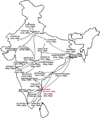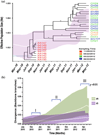Circulation and transmission of clones of Vibrio cholerae during cholera outbreaks
- PMID: 24407776
- PMCID: PMC4243509
- DOI: 10.1007/82_2013_360
Circulation and transmission of clones of Vibrio cholerae during cholera outbreaks
Abstract
Cholera is still a major public health problem. The underlying bacterial pathogen Vibrio cholerae (V. cholerae) is evolving and some of its mutations have set the stage for outbreaks. After V. cholerae acquired the mobile elements VSP I & II, the El Tor pandemic began and spread across the tropics. The replacement of the O1 serotype encoding genes with the O139 encoding genes triggered an outbreak that swept across the Indian subcontinent. The sxt element generated a third selective sweep and most recently a fourth sweep was associated with the exchange of the El Tor ctx allele for a classical ctx allele in the El Tor background. In Kenya, variants of this fourth selective sweep have differentiated and become endemic residing in and emerging from environmental reservoirs. On a local level, studies in Bangladesh have revealed that outbreaks may arise from a nonrandom subset of the genetic lineages in the environment and as the population of the pathogen expands, many novel mutations may be found increasing the amount of genetic variation, a phenomenon known as a founder flush. In Haiti, after the initial invasion and expansion of V. cholerae in 2010, a second outbreak occurred in the winter of 2011-2012 driven by natural selection of specific mutations.
Figures





References
Publication types
MeSH terms
Grants and funding
LinkOut - more resources
Full Text Sources
Other Literature Sources
Medical

